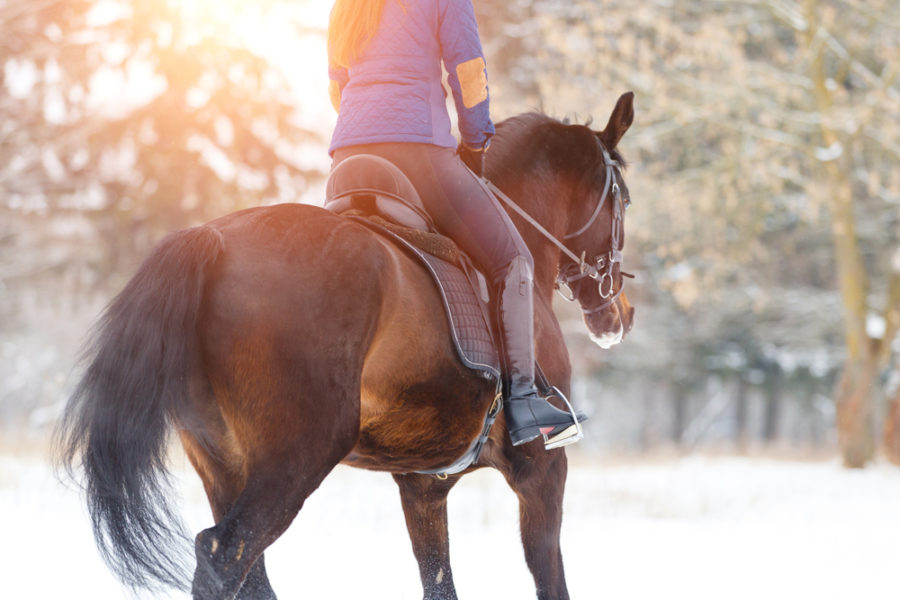Training and riding your horse in bad weather means keeping some important considerations in mind. Follow these winter horse training tips for a safer and more pleasant experience!
Winter horse training is a reality for many of us, and not everyone has access to a heated arena. But don’t fret – in snowy, icy climates where the temperature drops into the subzero range, there are still ways to continue your horse’s education and exercise routine.
Footing conditions
Check outdoor spaces before use
It’s difficult to judge what lies under snow, so be sure to check outdoor areas thoroughly before using them, and be wary on trails. Hard-packed uneven snow that’s been freshly covered spells trouble. Scraping snow from a riding area is a good idea, as long as you have space to pile it. Snow piles can harden into icy mounds that stay all winter – especially in freeze-thaw conditions – so be sure not to scrape them into high-traffic areas like paddocks.
Watch out for mud
In cold, wet regions such as northern coastlines, mud is a big concern for leg injuries. If you can, designate multiple training areas and use them on a rotational basis so they don’t become too rutted. If possible, skip training on really wet days.
Keep an eye out for black ice
Training your horse on icy ground can lead to leg splitting – when the horse’s legs separate too far in a certain direction. In the front legs, east-west splits can cause mild to severe damage (radial nerve paralysis), whereas north-south splits can cause extensive tendon/ligament damage, big vet bills, and a long recovery. Splitting hind legs can cause muscle and hip injuries.
Horses can also slip and fall on ice. This can lead to a number of issues, from minor bruising to possible fracture (shoulder/hip). Regardless of what injuries are sustained, a heavy horse hitting the frozen ground hurts!
Protect his hooves
Landing too hard on solid ground can result in hoof bruising or fractures (coffin bone). Hoof boots can help prevent this, and pour-in pads are becoming increasingly popular. Consult with your farrier to determine which option is best for you and your horse.
To protect your horse from getting snowballs, trim regularly. It helps keep snow from packing into hard balls that cause slight to severe rotation, depending on how and where you ride. Snowballing is a serious issue that can result in ringbone.
Your horse’s condition
Aim for longer rides
If you normally ride for 45 minutes in good weather, do your best to double it in cold weather. The colder the temperature, the longer your horse will take to warm up. Start by lunging him, and then proceed to a slow walk once you’re in the saddle. If you want to increase the intensity, wait until the latter half of your ride.
Adjust your speed
Winter is a good time to review numerous walk exercises. It’s still good exercise, and allows you to ride in slightly colder temperatures without fear of damaging lungs. Use this time to improve gaits and aids, perfect turns, and practice short transitions, bending and more.
You can also focus more on in-hand work, as it challenges a horse mentally and provides a high level of fitness, balance, and cadence without the high sweat factor. In-hand training switches to more of a mental exercise than a physical “workout”, and can offer a level of connection and obedience often missed under saddle.
Try interval training
Instead of working a horse hard and long, shorten your sessions and go for an “interval” style of training. This involves pushing the horse for short bursts, then moving slowly for longer periods. This style of training has its merits in any weather.
To sweat or not to sweat?
Sweating a horse in the winter should be kept to a minimum unless your grooming is done in a reasonably warm facility. The horse must be completely dry before returning to the outside.
Clipped horses dry faster but are more exposed to cold, so if you go for a long walk you may choose to use a special blanket for kidney warmth – it fits behind the saddle to the hip.
Adjust your grooming routine
Horses have special post-workout grooming requirements in the winter. Their coats consist of a shorter down-like insulating hair layer that utilizes dust and dirt phorses to increase heat. Try to dry the coat out fully after exercising your horse, but be careful not to groom all the dirt and natural oils out, as this provides protection!
Stick close to home
Most people won’t trailer horses in temperatures colder than 14°F (-10°C). If your new training regime consists of a lot of hauling, take the time to cool properly and bring appropriate blankets. Try not to haul horses in stock trailers in the winter.
Watch for warning signs
Winding a horse at any time is questionable, but in freezing temperatures cold can damage lung tissue. Horses that shiver after a ride or during trailering also need special attention.
Implementing a safe winter exercise routine will ensure your horse hits the ground running once spring returns! By taking a few extra precautions, making warm-ups a priority, and using the opportunity to learn additional skills, you can make winter training a huge success.







